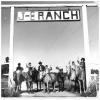Emmanuel Shearith Israel Chapel
Full Article
Located at what was once the corner of Tenth and Lawrence Streets in the middle of the Auraria Higher Education Center, Emmanuel Shearith Israel Chapel is the oldest surviving religious building in Denver. Built in 1876–77 as the Emmanuel Episcopal Church, the building was sold in 1903 to the Shearith Israel Jewish congregation. It served as a synagogue until 1958, when it was sold to the artist Wolfgang Pogzeba and later converted into the art gallery for the Auraria campus.
Episcopal Church
In 1873 Episcopalians in west Denver formed the Emmanuel Mission. The group started holding Sunday School at a grammar school building at the corner of Eleventh and Lawrence Streets. It soon grew to seventy members. With money from James C. Elms of Boston, who wanted a church built in memory of his daughter, the group constructed a small stone church at the north corner of Tenth and Lawrence Streets. The church, which measured only twenty-four feet by sixty-six feet, used a combination of Romanesque and Gothic styles. It was consecrated on September 24, 1877.
The Emmanuel Episcopal Church was the second Episcopal church in Denver. It remained at its Tenth and Lawrence location until the early 1890s. By that time the character of west Denver was changing as wealthier residents moved south of Colfax Avenue. Unable to maintain a congregation at Tenth and Lawrence, Emmanuel Episcopal moved in 1893 to a new building several blocks south, at West Twelfth Avenue and Lipan Street.
The Episcopal Church continued to own the building at Tenth and Lawrence. In the 1890s the Young Ladies Guild of St. John’s Cathedral operated a social welfare mission there. The building started to be known as St. Andrew’s Church and was used as the meeting place for a group of Anglo-Catholics (Episcopalians who emphasized the Catholic roots of their beliefs) that included white members from England and black members from Memphis, Tennessee. This Anglo-Catholic congregation eventually established the Church of the Holy Redeemer.
Jewish Synagogue
In the 1880s and 1890s, a diverse mix of ethnic groups, including eastern European Jews, began to move into west Denver. These new Jewish immigrants did not quite fit in with the city’s existing community of cosmopolitan German Jews, who had established the city’s oldest Jewish congregation, Temple Emanuel, in 1874. Instead, the new Jewish immigrants started many small congregations of their own, such as Shomro Amuno (Keepers of the Faith), which tended to reflect the local dialect and customs of their homelands in eastern Europe.
In the 1890s Shomro Amuno had a synagogue on the east bank of Cherry Creek known as the Cherry Creek Shul. The building was slowly sinking into the creek and the congregation was having trouble keeping up with the mortgage, so in 1898 Shomro Amuno moved out and started to hold its services in rented halls and stores. In 1899 it joined another group that also held services in nearby stores, and the combined congregation took the name Shearith Israel (Remnant of Israel).
For four years Shearith Israel held services in rented halls, but in 1903 the group was able to buy the old Emmanuel Episcopal Church at Tenth and Lawrence. Men from the congregation repaired the building and converted it into a synagogue. In 1906 the congregation started a Talmud Torah and was soon teaching Hebrew to dozens of neighborhood children. By 1911 the congregation had sixty-five members.
Shearith Israel survived as long as there was a Jewish community in west Denver. After World War I, the city’s Jewish community began to disperse from downtown and west Denver. Shearith Israel still had sixty members in 1920, but the area’s Jewish population was already in decline. By 1942 the congregation counted only fifteen members. Eventually, all the other west Denver shuls closed, leaving Shearith Israel as the last congregation in the area, used primarily by local businessmen as a convenient place to go for holidays, commemorations, and other special services. The synagogue closed for good in 1958.
Art Gallery
After the synagogue closed, the artists Wolfgang and Susan Pogzeba rented the building for several years before eventually buying it in 1963. They updated the building’s wiring and plumbing but otherwise left it largely unchanged. As plans for a vast urban renewal project in west Denver took shape in the late 1960s, the old church and synagogue began to receive historic designations to protect it from potential destruction. In 1968 it became the city’s first designated landmark, and in 1969 it was listed on the National Register of Historic Places.
In 1973 the Auraria Higher Education Center bought the building for $100,000. It was renovated in 1976 to become the campus art gallery. Now known as the Emmanuel Gallery, it regularly hosts exhibitions of work by students, professors, and other artists. Although the building’s interior has changed over the years, it still has a Hebrew inscription over its door as a reminder of its past.








